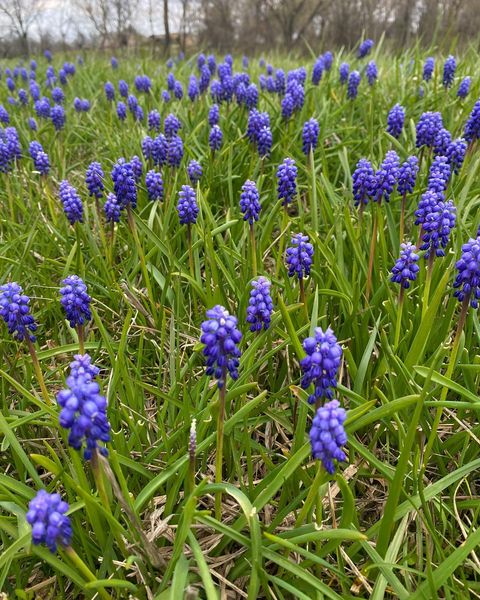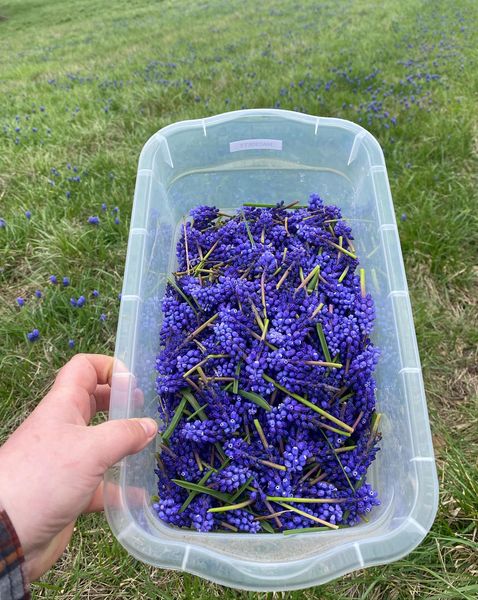- Joined
- Dec 3, 2017
- Messages
- 19,635
Muscari are very easy to grow and will take over a yard in time. Someone gave me some many years ago, and they are all over my yard. I keep digging them out and giving them away.
 These are called Muscari!
These are called Muscari!

Most people call them Grape Hyacinth but they are not a Hyacinth!! Keep in mind these are edible but the actual Hyacinth is not. It is toxic!
The Muscari are edible. The blossoms have a slightly sour, slightly grapey flavor, and are a source of Vitamins A and C. Although there are no poisonous parts on the Muscari, the blossoms are most often used, rather than their leaves, stems or roots.
Grape hyacinth blossoms are used as flavoring in Europe.
As with any wild edible, the sky is really the limit on how to use grape hyacinth in your kitchen. You can cook them up and simply eat them, or you can add them to your floral pasta.
Benefits of Muscari
Almost all the plants have some medicinal as well as nutritional value to offer.
Skin Benefits of Grape Hyacinth/Muscari
1. Treats Eczema:
The leaf extracts of this plant can be mixed with rice flour and turmeric to treat skin problems like eczema.
2. Makes Skin Healthy:
Many skin care products contain Muscari. The use of grape Hyacinth and its antimicrobial, antifungal and antibacteria properties make it the perfect choice for treating many skin disorders.
Hair Benefits:
3. Offer Great Fragrance to the Hair:
Though Muscari is not known for its hair care benefits but it provides the shampoos and conditioners that amazing fragrance to of a fresh flower.
Health Benefits:
4. Treats Cholera:
The stem of this plant can be used to treat cholera. Symptoms like nausea and vomitting can be reduced with the help of stir fried Muscari beans.
5. Heals Sore Throat:
The juice extracted from the pods of the Muscari plant can be used to heal an inflamed throat as well as ears.
10 Tips To Keep Your Skin Cool In The Summers
6. Treats Snake Bites:
A poultice, prepared with the extracts of the Gr. hyacinth bean leaves, can be used to treat snake bites.
Tea recipe: steep an early grey, jasmine,lemon grass and blue grape hyacinth flourets
Also delicious with lemonade
Simple syrup/blue grape hyacinth so delish
Bow tie pasta cold, 1/3 cup Vidalia onion dressing, 2 tbsp lemon poppyseed dressing, sliced strawberries fresh, 1 cup lightly cooked spinich cooled , topped with grape hyacinth.



https://www.facebook.com/rose.casta...N_uN-b5Crj9qvu3rVn6Sw93MKA&__tn__=<<,P-y0.g-R


Most people call them Grape Hyacinth but they are not a Hyacinth!! Keep in mind these are edible but the actual Hyacinth is not. It is toxic!
The Muscari are edible. The blossoms have a slightly sour, slightly grapey flavor, and are a source of Vitamins A and C. Although there are no poisonous parts on the Muscari, the blossoms are most often used, rather than their leaves, stems or roots.
Grape hyacinth blossoms are used as flavoring in Europe.
As with any wild edible, the sky is really the limit on how to use grape hyacinth in your kitchen. You can cook them up and simply eat them, or you can add them to your floral pasta.
Benefits of Muscari
Almost all the plants have some medicinal as well as nutritional value to offer.
Skin Benefits of Grape Hyacinth/Muscari
1. Treats Eczema:
The leaf extracts of this plant can be mixed with rice flour and turmeric to treat skin problems like eczema.
2. Makes Skin Healthy:
Many skin care products contain Muscari. The use of grape Hyacinth and its antimicrobial, antifungal and antibacteria properties make it the perfect choice for treating many skin disorders.
Hair Benefits:
3. Offer Great Fragrance to the Hair:
Though Muscari is not known for its hair care benefits but it provides the shampoos and conditioners that amazing fragrance to of a fresh flower.
Health Benefits:
4. Treats Cholera:
The stem of this plant can be used to treat cholera. Symptoms like nausea and vomitting can be reduced with the help of stir fried Muscari beans.
5. Heals Sore Throat:
The juice extracted from the pods of the Muscari plant can be used to heal an inflamed throat as well as ears.
10 Tips To Keep Your Skin Cool In The Summers
6. Treats Snake Bites:
A poultice, prepared with the extracts of the Gr. hyacinth bean leaves, can be used to treat snake bites.
Tea recipe: steep an early grey, jasmine,lemon grass and blue grape hyacinth flourets
Also delicious with lemonade
Simple syrup/blue grape hyacinth so delish
Bow tie pasta cold, 1/3 cup Vidalia onion dressing, 2 tbsp lemon poppyseed dressing, sliced strawberries fresh, 1 cup lightly cooked spinich cooled , topped with grape hyacinth.



https://www.facebook.com/rose.casta...N_uN-b5Crj9qvu3rVn6Sw93MKA&__tn__=<<,P-y0.g-R
